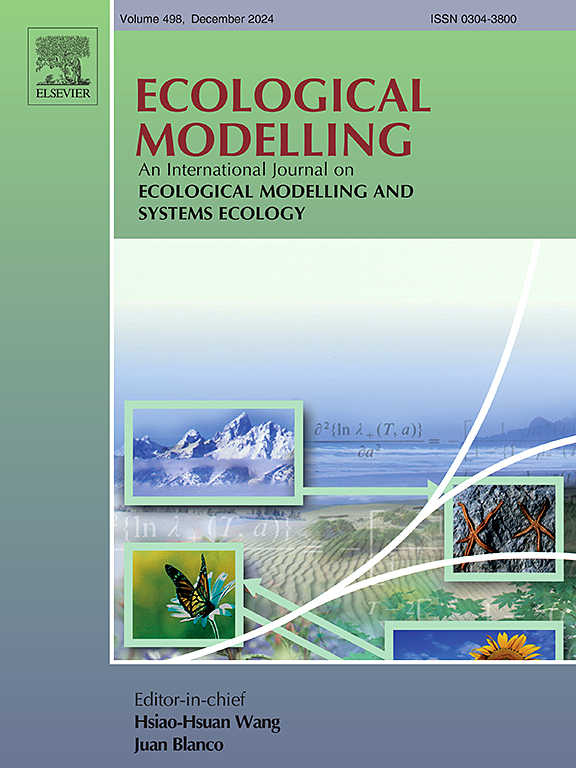A general DDE framework to describe insect populations: Why delays are so important?
IF 2.6
3区 环境科学与生态学
Q2 ECOLOGY
引用次数: 0
Abstract
Physiologically-based models are a valuable tool to describe the biology of terrestrial arthropods, as it is the case of insects. These models represent the division of the life cycle in various discrete stages and provide explicit connections with the external environment, making them good candidates for decision support system tools. However, despite the current literature offering good theoretical frameworks, most of them lack of a description of the minimum time required by the organisms to develop to the next life stage. This problem leads to an overestimation of the population and to a compression of the peaks of the generations, hindering their application in real scenarios. In this study we provide a new general model based on Delay Differential Equations (DDE) that overcomes the problem of the minimum development time by introducing time-dependent delays. Those delays generally depend not only on the biology of the species, but on time and on the environmental conditions. This theoretical extension has new implications from the parameter estimation point of view, which are discussed with the support of a case study of agronomic relevance: the brown marmorated stink bug Halyomorpha halys. Besides supporting the description of the model, the case of H. halys was also considered to validate the model using datasets from two geographical locations, for an overall of 5 fields. Simulations showed that the DDE model describes the experimental data better than its previous version based on ordinary differential equations. The model represents an overall step forward in theory development and can be of great support to describe multivoltine species.
描述昆虫种群的一般 DDE 框架:延迟为何如此重要?
以生理为基础的模型是描述陆生节肢动物生物学的重要工具,昆虫也是如此。这些模型将生命周期划分为不同的离散阶段,并提供了与外部环境的明确联系,使其成为决策支持系统工具的良好候选者。然而,尽管目前的文献提供了很好的理论框架,但其中大多数缺乏对生物体发育到下一个生命阶段所需的最短时间的描述。这个问题导致了对种群的高估和对世代峰值的压缩,阻碍了它们在实际场景中的应用。在本研究中,我们提供了一种基于延迟微分方程(DDE)的新通用模型,通过引入随时间变化的延迟来克服最短发育时间的问题。这些延迟一般不仅取决于物种的生物学特性,还取决于时间和环境条件。从参数估计的角度来看,这一理论扩展具有新的意义,我们将通过一个与农艺相关的案例研究:褐狨蝽(Halyomorpha halys)对其进行讨论。除了支持对模型的描述外,还考虑了 H. halys 的情况,利用来自两个地理位置的数据集对 5 块田地的总体情况进行了验证。模拟结果表明,与之前基于常微分方程的模型相比,DDE 模型能更好地描述实验数据。该模型代表了理论发展的整体进步,对描述多伏特物种有很大帮助。
本文章由计算机程序翻译,如有差异,请以英文原文为准。
求助全文
约1分钟内获得全文
求助全文
来源期刊

Ecological Modelling
环境科学-生态学
CiteScore
5.60
自引率
6.50%
发文量
259
审稿时长
69 days
期刊介绍:
The journal is concerned with the use of mathematical models and systems analysis for the description of ecological processes and for the sustainable management of resources. Human activity and well-being are dependent on and integrated with the functioning of ecosystems and the services they provide. We aim to understand these basic ecosystem functions using mathematical and conceptual modelling, systems analysis, thermodynamics, computer simulations, and ecological theory. This leads to a preference for process-based models embedded in theory with explicit causative agents as opposed to strictly statistical or correlative descriptions. These modelling methods can be applied to a wide spectrum of issues ranging from basic ecology to human ecology to socio-ecological systems. The journal welcomes research articles, short communications, review articles, letters to the editor, book reviews, and other communications. The journal also supports the activities of the [International Society of Ecological Modelling (ISEM)](http://www.isemna.org/).
 求助内容:
求助内容: 应助结果提醒方式:
应助结果提醒方式:


